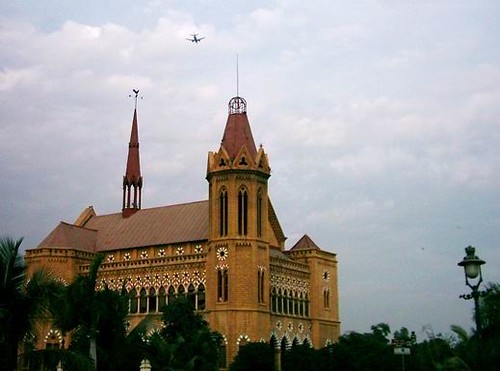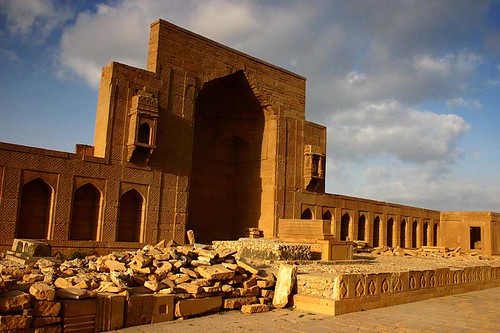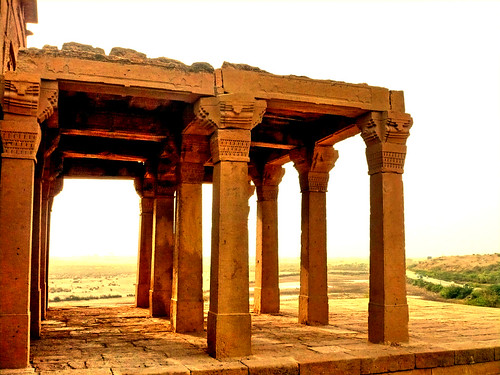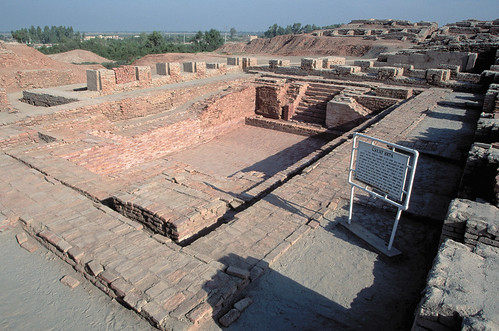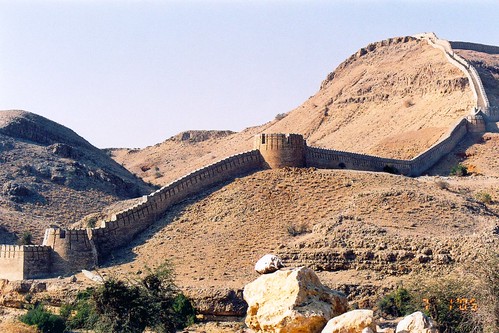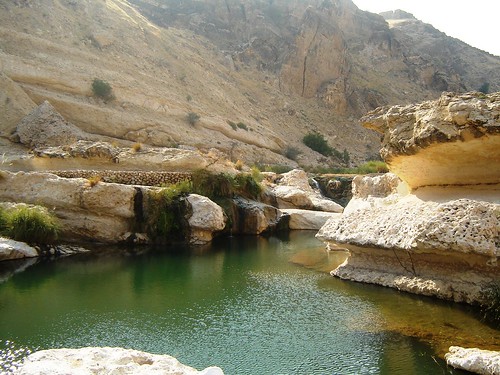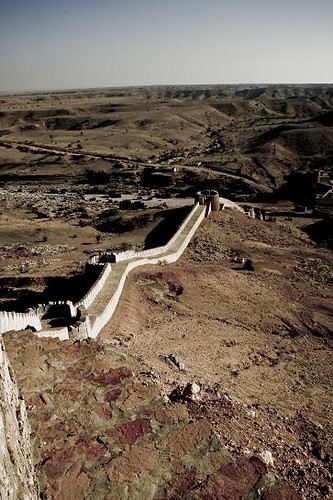 One of the largest necropolises in the world, with a diameter of approximately 8 kilometers, Makli Hill is believed to be the burial place of some 125,000 Sufi saints. It is located on the outskirts of Thatta, the capital of lower Sindh until the seventeenth century, in what is the southeastern province of present-day Pakistan. Legends abound about its inception, but it is generally believed that the cemetery grew around the shrine of the fourteenth-century Sufi, Hamad Jamali. The tombs and gravestones spread over the cemetery are material documents marking the social and political history of Sindh.
One of the largest necropolises in the world, with a diameter of approximately 8 kilometers, Makli Hill is believed to be the burial place of some 125,000 Sufi saints. It is located on the outskirts of Thatta, the capital of lower Sindh until the seventeenth century, in what is the southeastern province of present-day Pakistan. Legends abound about its inception, but it is generally believed that the cemetery grew around the shrine of the fourteenth-century Sufi, Hamad Jamali. The tombs and gravestones spread over the cemetery are material documents marking the social and political history of Sindh.
February 28, 2009
Makli Hill
February 27, 2009
Mohenjo-Daro
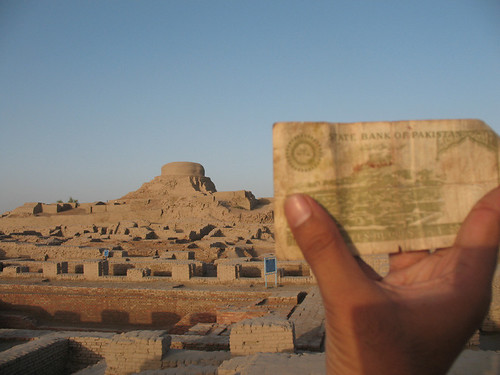 Mohenjo-Daro in ancient times was most likely one of the administrative centers of the ancient Indus Valley Civilization. It was the most developed and advanced city in South Asia, and perhaps the world, during its peak. The planning and engineering showed the importance of the city to the people of the Indus valley.
Mohenjo-Daro in ancient times was most likely one of the administrative centers of the ancient Indus Valley Civilization. It was the most developed and advanced city in South Asia, and perhaps the world, during its peak. The planning and engineering showed the importance of the city to the people of the Indus valley.
February 26, 2009
Ranikot Fort
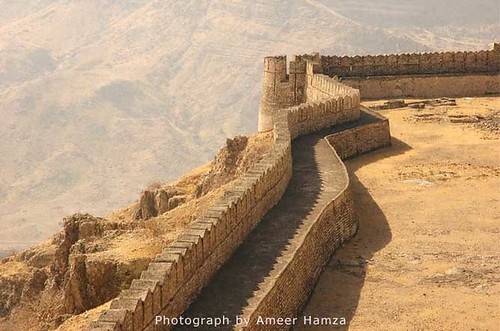 Ranikot Fort is the world's largest fort with a circumference of about 29 km or 18 miles. Who constructed it first and why? Is an enigma yet to be resolved by researchers. Some archaeologists attribute it to Arabs, possibly built by a Persian noble under the Abbasids by Imran Bin Musa Barmaki who was the Governor of Sindh in 836 CE. Others have suggested a much earlier period of construction attributing to at times the Sassanians, Persians, and at times to the Greeks. Despite the fact that a prehistoric site of Amri is nearby, there is no trace of any old city inside the fort and the present structure has little evidence of prehistoric origins.
Ranikot Fort is the world's largest fort with a circumference of about 29 km or 18 miles. Who constructed it first and why? Is an enigma yet to be resolved by researchers. Some archaeologists attribute it to Arabs, possibly built by a Persian noble under the Abbasids by Imran Bin Musa Barmaki who was the Governor of Sindh in 836 CE. Others have suggested a much earlier period of construction attributing to at times the Sassanians, Persians, and at times to the Greeks. Despite the fact that a prehistoric site of Amri is nearby, there is no trace of any old city inside the fort and the present structure has little evidence of prehistoric origins.
Archaeologists point to 17th century CE as its time of first construction but now Sindh archaeologists agree that some of the present structure was reconstructed by Mir Karam Ali Khan Talpur and his brother Mir Murad Ali in 1812 CE at a cost of 1.2 million rupees.
Fort Ranikot is located in Lakki Mountains of the Kirthar range on the right side of the mighty Indus River at a distance of about 30 kilometers from the present day town of Sann. A mountainous ridge, Karo Takkar(Black Hill), running north to south, forms its western boundary and the 'Lundi Hills' forms its eastern boundary. Mohan Nai, a rain-stream enters the fort from its rarely used western 'Mohan Gate', where it is guarded by a small fortification, changes its name to 'Reni' or 'Rani Nai' or rain-stream and gives the fort its name. Ranikot is thus the 'fort of a rain stream' - Rani. It runs through it, tumbles in a series of turquoise pools to irrigate fields and leaves the fort from its most used 'Sann Gate' on the eastern side. It then travels about 33 kilometers more to enter the Lion River - Indus.
Most of the twenty kilometers long wall is made of natural cliffs and barricades of mountainous rocks which at places rise as high as two thousand feet above sea level! Only about 8.25 km portions of its wall are man-made, built with yellow sandstone. This was first measured on foot by Badar Jamal Abro along with local guide Sadiq Gabol . As one enters the fort, one can find hills, valleys, streams, ditches, ponds, pools, fossils, building structure, bastions, watchtowers, ammunition depots, fortresses - all inside Ranikot, adding more to its beauty and mystery. A spring emerging from an underground water source near the Mohan Gate is named as 'Parryen jo Tarr' (the spring of fairies). According to a tale told by the local inhabitants, fairies come from far and wide on the Ponam Nights (full moon) to take bath at this spring near 'Karo Jabal'! Splashing sounds of water falling on the rocks can be heard at another spring, Waggun jo Tarr or "the Crocodile Spring", named so as crocodiles once lived there.
Within Ranikot, there are two more fortresses - Meeri and Shergarh, both have 5 bastions each. Meerikot takes its name from the word 'Mir' meaning top (for instance the top of a hill, chief of any baloch tribe, etc.). Both the main Ranikot and the inner Meerikot have similar entrances - curved, angulated with a safe tortuous path. "The bridge in front of Ranikot resembles to a smaller bridge in front of a fortress in Verona, Italy" writes Ishtiaq Ansari, the writer of 'Sindh ja koat aaein qillaa' (Forts and Fortresses of Sindh) and a member of Sindh Exploration and Adventure Society. From the military point of view, Meerikot is located at a very safe and central place in the very heart of the Ranikot with residential arrangements including a water-well. Talpur Mirs used Meerikot as their fortified residence. One can explore ruins of the court, harem, guest rooms, and soldiers quarters inside it. Its 1435 feet long wall has five bastions. Every structure in the Ranikot has its own uniqueness and beauty. Looking up from Meerikot one can find another fortified citadel - Shergarh (Abode of Lions) built with whitish stone, it too has five bastions. Though its location at 1480 feet above the sea level makes this fortress a unique structure, it also makes it equally difficult for supply of water, which can only be had from the brooks and rain streams, hundreds of feet below.The steep climb up to Shergarh gives a commanding view down over the whole fort and its entrance and exit points. On a clear day one can even see Indus, 37 kilometers away to the east.
Beside the Mohan Gate and the Sann Gate, there are two more gates, rather pseudo gates. One is towards the side of ancient town of Amri. This 'gate' is called the 'Amri Gate'. Certainly it takes its name from the prehistoric ruins of Amri, but it must have taken this name much later than the times of Amri as the fort itself doesn't appears to be as old as the Amri itself. In fact there is a bridge over rain stream 'Toming Dhoro' exiting from the fort called 'Budhi Mori'. The breach in fort wall due to the river stream has been referred as a gate. Similarly, the Shahpir Gate to the south also appears to be a pseudo gate taking its name from a limestone rock with a rough shape of foot imprinted on it. The sacred footprint supposedly belongs to Hazrat Ali or some other religious personality and is venerated by locals. It seems to be a later breach in the fort wall instead of a formal gate because one can't find any bastion or watchtower or their remains at the site, needed to guard any formal entrance or exit points.
February 25, 2009
Taj Building
 Taj Building is an architectural jewel on the main Grand Trunk Road in Nowshera, NWFP. Built in 1920s, this imposing structure has endured the ravages of time despite lack of any concerted attempts in the past to preserve it. The facade of the three-storey building is highly decorated with floral and vine patterns in intricate stucco. The sweeping round arches and numerous embellished columns represent a charming architectural blend of Roman, Gothic and Oriental. An arched gateway on the side of the building with beautiful jharoka-styled (elevated window balcony) features leads into the main compound. The building was constructed by Khan Bahadur Taj Muhammad Khan OBE MLC of Badrashi Village, Nowshera. He was a famous colonial-era contractor and landlord whose father KB Abdul Hamid Khan had been in the service of the British Empire as well. He was a wealthy man and was particularly fond of racehorses. He used to travel extensively in India and had built several grand mansions for his own comfort. The present National Defence College building in New Delhi, India was also his personal mansion.
Taj Building is an architectural jewel on the main Grand Trunk Road in Nowshera, NWFP. Built in 1920s, this imposing structure has endured the ravages of time despite lack of any concerted attempts in the past to preserve it. The facade of the three-storey building is highly decorated with floral and vine patterns in intricate stucco. The sweeping round arches and numerous embellished columns represent a charming architectural blend of Roman, Gothic and Oriental. An arched gateway on the side of the building with beautiful jharoka-styled (elevated window balcony) features leads into the main compound. The building was constructed by Khan Bahadur Taj Muhammad Khan OBE MLC of Badrashi Village, Nowshera. He was a famous colonial-era contractor and landlord whose father KB Abdul Hamid Khan had been in the service of the British Empire as well. He was a wealthy man and was particularly fond of racehorses. He used to travel extensively in India and had built several grand mansions for his own comfort. The present National Defence College building in New Delhi, India was also his personal mansion.

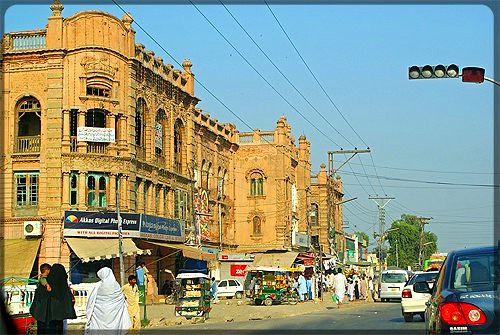
February 24, 2009
Shalimar Gardens
 Located in Lahore, The site of the Shalimar Gardens originally belonged to one of the noble Zaildar families in the region, well known as Mian Family Baghbanpura. The family was also given the Royal title of 'Mian' by the Mughal Emperor, for its services to the Empire. Mian Muhammad Yusuf, then the head of the Mian family, donated the site of Ishaq Pura to the Emperor Shah Jahan, after pressure was placed on the family by the royal engineers who wished to build on the site due to its good position and soil. In return, Shah Jahan granted the Mian family governance of the Shalimar Gardens. The Shalimar Gardens remained under the custodianship of this family for more than 350 years. In 1962, the Shalimar Gardens were nationalised by General Ayub Khan because leading Mian family members had opposed his imposition of martial law in Pakistan. The Mela Chiraghan festival used to take place in the Gardens, until President Ayub Khan ordered against it in 1958.
Located in Lahore, The site of the Shalimar Gardens originally belonged to one of the noble Zaildar families in the region, well known as Mian Family Baghbanpura. The family was also given the Royal title of 'Mian' by the Mughal Emperor, for its services to the Empire. Mian Muhammad Yusuf, then the head of the Mian family, donated the site of Ishaq Pura to the Emperor Shah Jahan, after pressure was placed on the family by the royal engineers who wished to build on the site due to its good position and soil. In return, Shah Jahan granted the Mian family governance of the Shalimar Gardens. The Shalimar Gardens remained under the custodianship of this family for more than 350 years. In 1962, the Shalimar Gardens were nationalised by General Ayub Khan because leading Mian family members had opposed his imposition of martial law in Pakistan. The Mela Chiraghan festival used to take place in the Gardens, until President Ayub Khan ordered against it in 1958.
More Pics: [CLICK 2 ENLARGE]

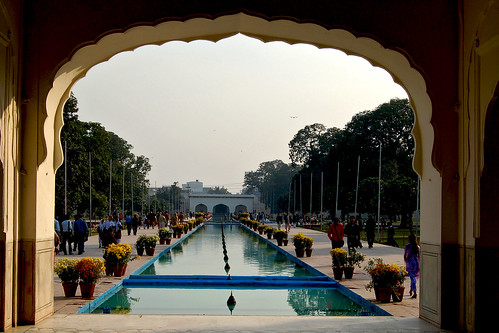




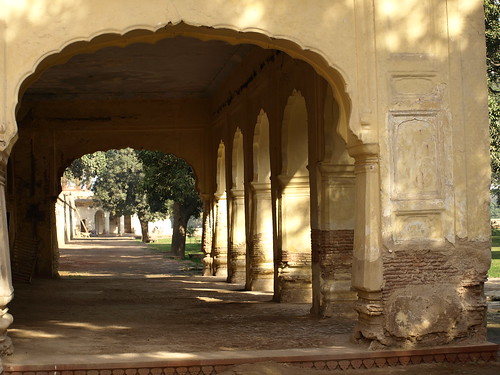

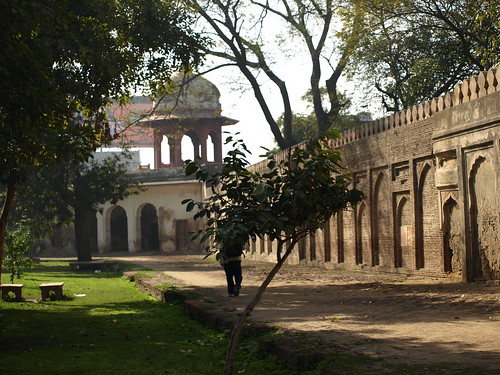
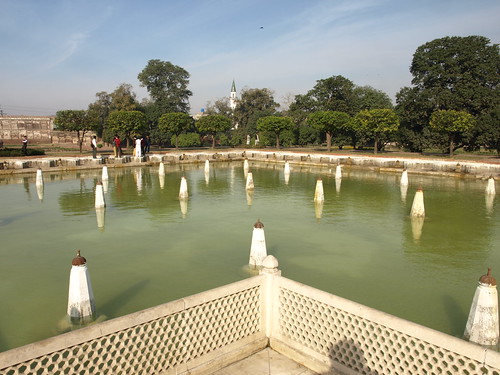
February 22, 2009
Hiran Minar
 The Mughal Emperor Jehangir enjoyed hunting around the area known as Sheikhpura. In 1616 he built a hunting pavilion at the centre of an artificial lake, and the Hiran Minar, a tower in the memory of his pet deer. In 1619 he built e massive red brick fort, which is still standing.The lake is square and held by bricks and is well stocked with fish. A little arched pavilion stand at each corner of the lake and steps lead down to the water. An arched causeway leads to the three-storey octagonal pavilion in the centre, where Jahangir sat in the graceful arcade and watched the wild animals drawn to the water. Near the end of the causeway stands the deer tower, dedicated to the deer Jahagir called Mansaraj.
The Mughal Emperor Jehangir enjoyed hunting around the area known as Sheikhpura. In 1616 he built a hunting pavilion at the centre of an artificial lake, and the Hiran Minar, a tower in the memory of his pet deer. In 1619 he built e massive red brick fort, which is still standing.The lake is square and held by bricks and is well stocked with fish. A little arched pavilion stand at each corner of the lake and steps lead down to the water. An arched causeway leads to the three-storey octagonal pavilion in the centre, where Jahangir sat in the graceful arcade and watched the wild animals drawn to the water. Near the end of the causeway stands the deer tower, dedicated to the deer Jahagir called Mansaraj.

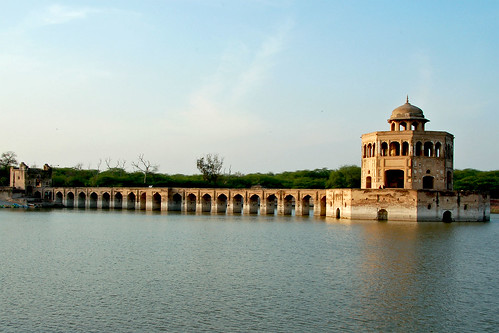

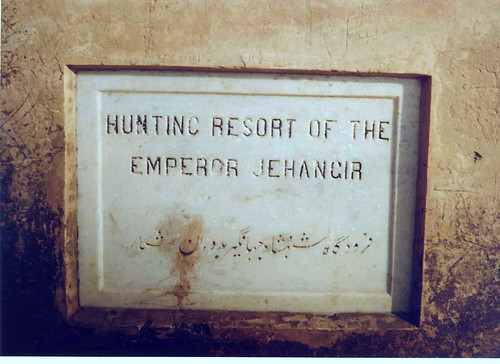
February 21, 2009
Frere Hall
 Frere Hall is one of the few well-preserved buildings from the days of the British Raj that still exists in Karachi. It was built in honour of Sir Henry Bartle Edward Frere (1815-1884), who was known for promoting economic development in Karachi. The Hall is located between Abdullah Haroon Road (formerly Victoria Road) and Fatima Jinnah Road (formerly Bonus Road) in the middle of two lawns which extended till the roads. In the vicinity are the the Marriott Hotel, US Consulate and Consul General's house, the Japanese Consulate and the Sind Club.
Frere Hall is one of the few well-preserved buildings from the days of the British Raj that still exists in Karachi. It was built in honour of Sir Henry Bartle Edward Frere (1815-1884), who was known for promoting economic development in Karachi. The Hall is located between Abdullah Haroon Road (formerly Victoria Road) and Fatima Jinnah Road (formerly Bonus Road) in the middle of two lawns which extended till the roads. In the vicinity are the the Marriott Hotel, US Consulate and Consul General's house, the Japanese Consulate and the Sind Club.

